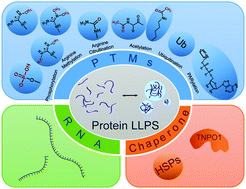Regulation of liquid–liquid phase separation with focus on post-translational modifications
Abstract
Liquid–liquid phase separation (LLPS), a type of phase transition that is important in organisms, is a unique means of forming biomolecular condensates. LLPS plays a significant role in transcription, genome organisation, immune response and cell signaling, and its dysregulation may cause neurodegenerative diseases and cancers. Exploring the regulatory mechanism of LLPS contributes to the understanding of the pathogenic mechanism of abnormal phase transition and enables potential therapeutic targets to be proposed. Many factors have been found to regulate LLPS, of which post-translational modification (PTM) is among the most important. PTMs can change the structure, charge, hydrophobicity and other properties of the proteins involved in phase separation and thereby affect the phase transition behaviour. In this review, we discuss LLPS and the regulatory effects of PTMs, RNA and molecular chaperones in a phase separation system. We introduce several common PTMs (including phosphorylation, arginine methylation, arginine citrullination, acetylation, ubiquitination and poly(ADP-ribosyl)ation), highlight recent advances regarding their roles in LLPS and describe the regulatory mechanisms behind these features. This review provides a detailed overview of the field that will help further the understanding of and interventions in LLPS.

- This article is part of the themed collection: Multimolecular Crowding in Biosystems


 Please wait while we load your content...
Please wait while we load your content...